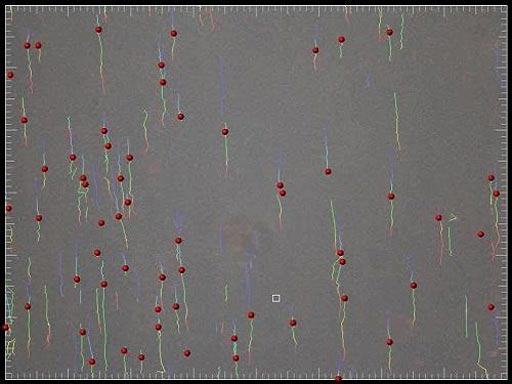Ligand Identification May Lead to Targeted Therapy for Chronic Diseases
By LabMedica International staff writers
Posted on 06 Jun 2017
A comprehensive analysis of E-selectin ligands expressed on activated human T-cells resulted in the identification of several novel glycoproteins that function as E-selectin ligands.Posted on 06 Jun 2017
E-selectins recognize and bind to sialylated carbohydrates present on the surface proteins of certain leukocytes. E-selectin ligands are expressed by neutrophils, monocytes, eosinophils, memory-effector T-like lymphocytes, and natural killer cells. Each of these cell types is found in acute and chronic inflammatory sites in association with expression of E-selectin, thus implicating E-selectin in the recruitment of these cells to such inflammatory sites.

Image: Single cell tracking trajectories (flow is bottom to top) of cells expressing E-selectin (red spheres) rolling over CD44 purified from T-cells over time (Photo courtesy of Dr. Jasmeen Merzaban, King Abdullah University of Science & Technology).
Investigators at King Abdullah University of Science & Technology (Thuwal, Saudi Arabia) compared the role of P-selectin glycoprotein ligand-1 (PSGL-1) and CD43, known E-selectin ligands, to CD44, a ligand that had not previously been characterized as an E-selectin ligand on activated human T-cells. The investigators used a small interfering RNA (siRNA) knockdown approach in primary activated human T-cells to block expression of all three ligands, individually and in combination. In addition, they assessed the binding of the ligands to E-selectin in T-cells isolated from patients with the chronic inflammatory disease psoriasis.
Results published in the May 3, 2017, online edition of the journal Frontiers in Immunology revealed that CD44 acted as a functional E-selectin ligand when expressed on both CD4+ and CD8+ T-cells. Moreover, the CD44 protein carried a binding epitope identifying it as hematopoietic cell E- and/or L-selectin ligand (HCELL). Knocking down the three ligands individually or together by selective siRNA treatment in primary activated human T-cells, demonstrated that CD44/HCELL, and not CD43, cooperated with PSGL-1 as a major E-selectin ligand. The relevance of these findings to chronic autoimmune disease was demonstrated by showing that CD44/HCELL and PSGL-1, but not CD43, from T-cells isolated from psoriasis patients, bound E-selectin.
The results presented in this study have significant implications in the development of targeted therapies to combat inflammatory diseases where T-cell trafficking is more dependent on E-selectin expression (for example, psoriasis and rheumatoid arthritis) to selectively interfere with the progress of these diseases through the targeting of a subset of these major E-selectin ligands.
"This has significant implications for developing targeted therapies to combat inflammatory diseases such as psoriasis and rheumatoid arthritis," said senior author Dr. Jasmeen Merzaban, assistant professor of bioscience at King Abdullah University of Science & Technology.
Related Links
King Abdullah University of Science & Technology













